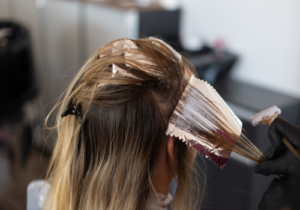The decision to return to your natural color after coloring can be a transformative journey for many of us. Whether you've opted for a bright hue, bold highlights or even permanent color, restoring your original shade requires not only patience, but also a thorough understanding of the effects of coloring. Learning how to restore your natural color after coloring is essential to minimize damage and promote a smooth transition.
Understanding the impact of color on your hair
The effects of different types of color
Permanent colorations
Permanent colorations take the longest to last, as they modify the hair's structure in depth. In fact, these colorings generally contain chemical agents such as ammonia and peroxide, which open up the hair cuticle to allow pigments to penetrate the cortex. This chemical transformation can lead to lasting alteration of texture and loss of the hair's original natural color.
Semi-permanent colorations
Semi-permanent colorations, on the other hand, are less aggressive, as they generally do not involve the use of ammonia. They deposit pigments on the hair's surface, which is why they fade gradually. Nevertheless, depending on the frequency and color chosen, they can subtly influence the natural tone over time.
The impact of color on hair structure
The role of pH in hair coloring
The hair coloring process is highly dependent on the hair's pH balance. Colorants generally have a high pH, which opens the cuticle and facilitates pigment penetration. However, an unbalanced pH can weaken the cuticle and disrupt the hair's ability to maintain its natural color and texture.
Possible damage caused by coloring
Beyond color changes, coloring can compromise the structural integrity of hair. Potential damage includes excessive dryness, hair fiber breakage and a lack of shine. These undesirable effects underline the importance of proper hair care to protect hair during and after the transition to its natural color.

Prepare your hair to regain its natural color
The importance of patience and time in the process
Patience is essential when considering a return to your natural hair color. The process can take several months or even more than a year, depending on the length of your hair and the intensity of your previous coloring. It's important to bear in mind that forcing the transition too quickly can cause further damage to the hair. Each step should be carefully considered, allowing the hair to regenerate and strengthen gradually.
Establishing an appropriate hair care regimen
To promote the recovery of natural color, it's crucial to establish a proper hair care routine. This involves using specific products that nourish and protect the hair fiber.
Regular use of hair masks
Hair masks are essential for maintaining healthy hair throughout this process. Opt for conditioning masks rich in natural ingredients such as coconut, argan or avocado oils. These masks help moisturize, repair hair fibers damaged by coloring and improve elasticity, easing the transition to natural color.
The importance of reducing heat consumption
Reducing hair's exposure to heat is another crucial factor in protecting the structure of hair fibers. Frequent use of hair dryers, straightening irons or curling irons can weaken hair and delay the return of natural color. Prioritize air-drying and the use of thermoprotective products when the application of heat is unavoidable.
Adopting these practices can go a long way towards preserving hair health during this delicate transition phase. The aim is to minimize damage caused by coloring, while fostering a healthy hair environment that will encourage the return of your natural color, full of vitality and shine.
See also: How to repair hair damaged by bleaching?
The different methods for restoring your natural color
Let your hair grow without coloring it
A natural approach to regaining original color is to simply let the hair grow until the coloring is completely removed. This process requires patience, but is totally chemical-free, so hair is protected and strengthened over time. During this period, it may be a good idea to trim the ends regularly to gradually eliminate colored sections, while promoting healthy hair growth.
Using bleach
The use of a bleach is a more radical but effective method of returning hair to its natural color. It involves removing the artificial pigments present in the hair fiber to reveal the underlying color or a more neutral tone, before allowing the natural color to grow in.
When to use bleach
Bleach is often recommended when hair has been dyed with very dark dyes or extravagant colors that don't blend naturally with root color. It can be used to even out the tint as the hair grows or before starting a lighter repigmentation process.
Precautions to take with bleach
The bleaching process can be harsh on the hair and requires special precautions. It is important to carry out a preliminary test to assess the hair's reaction to the product. In addition, it's advisable to call in a professional to ensure correct, even application, minimizing the risk of staining or burning. After use, intensive care with moisturizing and repairing products is essential to revitalize weakened hair.
Opt for tone-on-tone color
Tone-on-tone coloring can be used to harmonize the difference between the natural color regrowth and the treated color, without permanently altering the structure.
The tone-on-tone coloring technique
This method involves applying a dye whose shade is as close as possible to the hair's natural base. Unlike permanent hair color, it does not penetrate deep into the hair fiber, helping to preserve the hair's integrity. What's more, it adds shine and softness, facilitating a more subtle transition to natural color.
It's important to note that there's no one-size-fits-all solution, and the choice of method will depend on personal preference and hair condition. Whatever path you choose, it's vital to give your hair the time and care it needs to ensure its health during this process of returning to its original shade.

Integrating a healthy lifestyle and habits to support the transition
Eat a nutrient-rich diet
A balanced diet plays a crucial role in the overall health of hair, especially during the transition to natural color. Consuming foods rich in vitamins, minerals, and essential fatty acids such as omega-3, biotin, and vitamins A, C and E can strengthen hair, improve growth and reduce breakage. Green vegetables, nuts, oily fish and fruit can all contribute to hair vitality.
Regular hydration
Regular hydration is essential to hair health and appearance. Drinking enough water helps maintain optimal hydration of hair cells, which can contribute to hair shine and soft texture. As a complement, the use of moisturizing treatments such as jojoba or castor oil can offer extra hydration and protection against external aggressors.
Develop gentle styling habits
Hair care is not limited to the products used, but also includes styling habits. Avoid over-tightening your hair by using bandanas or too-tight elastics, which can cause breakage. Use wide-tooth combs and brush your hair gently to minimize damage. Incorporating protective hairstyles can also help preserve hair integrity during the transition.
Avoid aggressive chemicals and undesirable products
During the return to natural color, it's essential to minimize the use of harsh chemicals. Switching to gentle, sulfate- and paraben-free shampoos and conditioners will help protect the hair cuticle. In addition, reducing the use of hair care products containing alcohol can help prevent dehydration and hair fragility.
Managing stress and its effects on hair
Stress can have an impact on hair health, sometimes causing hair loss or brittleness. Implementing stress management techniques such as meditation, yoga or regular physical activity can have a positive impact not only on overall health, but also on hair quality and growth.
FAQ
How can I reduce the demarcation between colored hair and my natural color?
One method is to opt for highlights or sweeps that help gradually harmonize the transition.
What role does regular trimming of the tips play in the transition to my natural color?
Regular trimming of the ends eliminates damaged and colored sections, promoting healthy, natural-looking hair.
Does going back to my natural color accelerate hair growth?
Returning to natural color doesn't specifically accelerate hair growth, but reduces damage and improves overall condition for optimal growth.
Does coconut oil really help to restore my natural color?
Yes, coconut oil helps nourish and strengthen the hair fiber, providing shine and protection during the transition process.
Is it necessary to completely stop all coloring during the transition?
Ideally, coloring should be kept to a minimum to avoid further damage to the hair, although solutions such as tone-on-tone coloring can occasionally be used.





